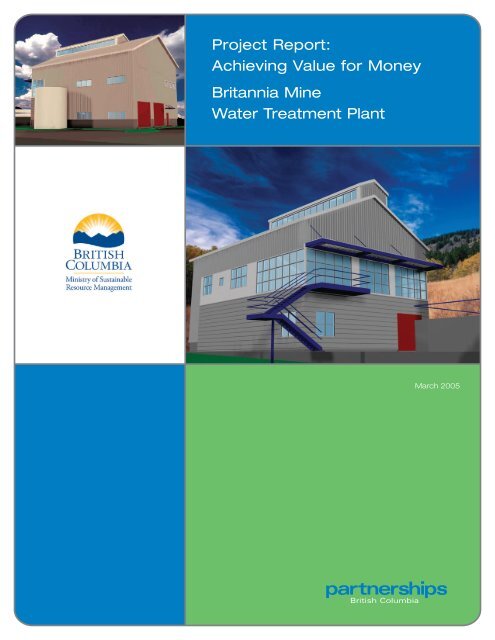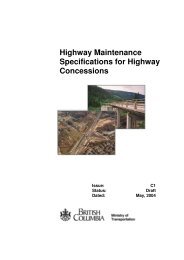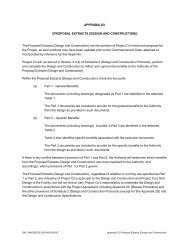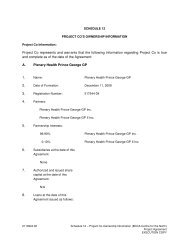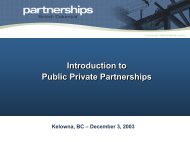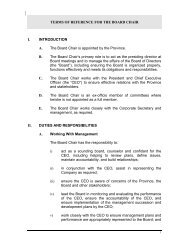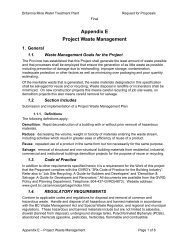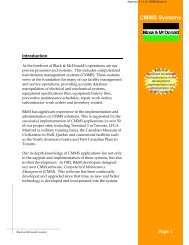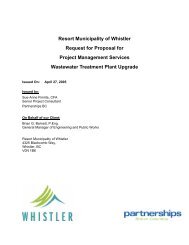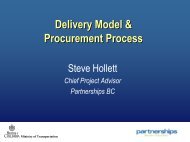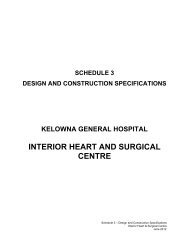Project Report - Partnerships British Columbia
Project Report - Partnerships British Columbia
Project Report - Partnerships British Columbia
You also want an ePaper? Increase the reach of your titles
YUMPU automatically turns print PDFs into web optimized ePapers that Google loves.
<strong>Project</strong> <strong>Report</strong>:<br />
Achieving Value for Money<br />
Britannia Mine<br />
Water Treatment Plant<br />
March 2005
Purpose of this Document<br />
As part of its commitment to public accountability,<br />
the Province releases a project report,<br />
demonstrating how value for money has been<br />
achieved for each major public private partnership<br />
agreement it enters on behalf of <strong>British</strong> <strong>Columbia</strong>ns.<br />
Value for money is a broad term that captures both<br />
quantitative factors, such as costs, and qualitative<br />
factors, such as service quality and protection of<br />
public interests.<br />
Value for money is one of six key principles guiding<br />
public sector capital asset management in <strong>British</strong><br />
<strong>Columbia</strong>. The others are:<br />
• sound fiscal and risk management;<br />
• strong accountability in a flexible and streamlined<br />
process;<br />
• emphasis on service delivery;<br />
• serving the public interest; and<br />
• competition and transparency.<br />
Since 2002, these principles have guided the B.C.<br />
public sector’s approach to acquiring and managing<br />
assets such as roads, bridges and health care<br />
facilities. Under the Capital Asset Management<br />
Framework, ministries and other public bodies such<br />
as health authorities are encouraged to consider all<br />
available options for meeting their service<br />
objectives. They analyze the options and, after<br />
considering the qualitative and quantitative<br />
advantages and disadvantages of each, choose the<br />
one that overall best meets service delivery needs<br />
and makes the best use of taxpayers’ dollars.<br />
In all of its procurement processes, including public<br />
private partnership agreements, the Province is<br />
committed to a high standard of public disclosure to<br />
ensure accountability. This report describes the<br />
rationale, objectives and processes that led to the<br />
use of a public private partnership for the Britannia<br />
Mine Water Treatment Plant <strong>Project</strong>, giving the<br />
public a clear sense of how and why the decision<br />
was reached to proceed with that option. It explains<br />
how value for money was measured, and how it was<br />
achieved, in the context of current market<br />
conditions. Where applicable, it also compares key<br />
aspects of the final agreement to other options<br />
considered for the project.<br />
For more on the Province’s Capital Asset<br />
Management Framework, go to<br />
http://www.fin.gov.bc.ca/tbs/camf.htm<br />
For more on public private partnerships in B.C., go<br />
to www.partnershipsbc.ca<br />
In some cases, the best option may be traditional<br />
procurement – where assets are purchased entirely<br />
with taxpayers’ money and operated exclusively by<br />
the public sector. In other cases, agencies may find<br />
innovative ways to meet their service needs without<br />
acquiring capital assets. In all cases, agencies are<br />
publicly accountable through regular budgeting,<br />
auditing and reporting processes.<br />
i
Highlights<br />
The Britannia Mine water treatment plant is an<br />
integral part of the Ministry of Sustainable Resource<br />
Management’s (MSRM) environmental remediation<br />
of an abandoned mine site between Vancouver and<br />
Whistler. Left untreated, contaminated water from<br />
the mine site would continue to deposit on average,<br />
600 kilograms of metals into Howe Sound on a daily<br />
basis. The water treatment plant will treat up to<br />
500,000 cubic metres per year of contaminated<br />
mine water before it drains into Howe Sound.<br />
The Province’s approach to treating the water at the<br />
Britannia Mine site is a remarkable achievement for<br />
a number of reasons.<br />
• The project is the first of its kind in B.C. – solving the<br />
problem of contaminated water from an abandoned<br />
mine site through a public private partnership.<br />
• The private partner, EPCOR Britannia Water Inc.<br />
(EPCOR), has introduced innovation related to the<br />
water treatment process, plant operation and<br />
water quality monitoring.<br />
• The Province has successfully protected<br />
taxpayers from the risks involved with developing<br />
and implementing ways to effectively treat the<br />
mine water, by sharing these risks with EPCOR.<br />
• This project demonstrates that value for money<br />
can be achieved with smaller scale public<br />
private partnerships. The net present value<br />
lifecycle cost of the project is $27.2 million,<br />
which is $10 million less than the estimated cost of<br />
completing the plant through traditional methods.<br />
Achieving Value for Money<br />
The Britannia Mine water treatment plant will be<br />
designed, built, financed and operated as a public<br />
private partnership, and is part of a larger<br />
remediation effort being managed by the Ministry of<br />
Sustainable Resource Management (MSRM).<br />
When compared to traditional delivery of the treatment<br />
plant, the partnership agreement with EPCOR:<br />
• reflects lifecycle savings because of EPCOR’s<br />
experience in water treatment;<br />
• provides technological innovation that reduces<br />
costs by, for example, reducing the amount of<br />
chemicals needed to treat the water, and reducing<br />
site electricity costs by developing a small hydro<br />
generation plant that will produce electricity from<br />
the contaminated water as it flows from the mine<br />
and into the water treatment plant;<br />
• ensures regulatory compliance by transferring<br />
the risk of financial penalties for non-compliance<br />
to EPCOR.<br />
In short, the Province will have a better water<br />
treatment plant, at a lower cost and with less risk to<br />
taxpayers, by entering into a partnership with EPCOR<br />
Britannia Water Inc.<br />
Key Terms of the Agreement<br />
The Britannia Mine Water Treatment Plant <strong>Project</strong><br />
involves the design, construction, financing and<br />
operation of a water treatment plant, over a 21 year<br />
period. Through a public private partnership between<br />
MSRM and EPCOR:<br />
• EPCOR will design and build the plant within one year,<br />
and operate the plant for 20 years after construction;<br />
• EPCOR will finance the design, construction,<br />
operation and maintenance of the plant;<br />
• MSRM will provide performance-based payments to<br />
EPCOR, with the amount calculated based on the<br />
volume of water processed, and the ability of the<br />
plant to meet environmental regulations;<br />
• Performance payments will not begin until the plant<br />
is in operation;<br />
• EPCOR will take on responsibility for much of the<br />
risk associated with designing, building and<br />
operating the plant, such as the risk of incurring<br />
financial penalties if the plant is not built and in<br />
operation on time, or if the treatment of water is not<br />
in compliance with environmental regulations.<br />
EPCOR works with municipalities and companies<br />
across western Canada. In B.C., the company provides<br />
water and wastewater services to the District of Sooke,<br />
the District of Port Hardy and the town of Lytton.<br />
ii<br />
<strong>Project</strong> <strong>Report</strong>: Achieving Value for Money – Britannia Mine Water Treatment Plant
Table of Contents<br />
1. <strong>Project</strong> Background and Objectives . . . . . . . . . . . . . . . . . . . . . . . . . . . . . . . . .1<br />
2. Competitive Selection Process . . . . . . . . . . . . . . . . . . . . . . . . . . . . . . . . . . . . .3<br />
3. The Final Agreement . . . . . . . . . . . . . . . . . . . . . . . . . . . . . . . . . . . . . . . . . . . . .5<br />
4. Ongoing Monitoring . . . . . . . . . . . . . . . . . . . . . . . . . . . . . . . . . . . . . . . . . . . .12
1. <strong>Project</strong> Background and Objectives<br />
Background<br />
Contaminated water from the abandoned Britannia<br />
Mine site has been flowing into Howe Sound.<br />
The Britannia Mine is located approximately<br />
48 kilometres north of Vancouver at Britannia Beach,<br />
on the east shore of Howe Sound. The Britannia<br />
Mine was one of the biggest copper producers in<br />
the <strong>British</strong> Empire, operated from 1904 to 1963 by<br />
the Britannia Mining and Smelting Company Ltd.<br />
and by Anaconda<br />
Mining Company<br />
from 1963 until<br />
permanent shutdown<br />
in 1974.<br />
During operation,<br />
approximately 80<br />
The historic Britannia Mine site kilometres of<br />
underground<br />
workings and five open pits were excavated, with<br />
the ore processed in the milling facilities at Britannia<br />
Beach. Exposure of the excavations to air and water<br />
results in the generation of acid rock drainage<br />
(ARD), which has been flowing into Howe Sound<br />
and adversely affecting the marine habitat offshore<br />
of Britannia Creek. The heavy metals in the water,<br />
such as copper, zinc and cadmium, are toxic to the<br />
marine life on the foreshore and to juvenile salmon<br />
which use the area for feeding.<br />
In 2001, the Province entered into an agreement<br />
with the former mine operators where the operators<br />
contributed $30 million toward the remediation of the<br />
site, in exchange for a provincial guarantee that they<br />
would not be held liable for future issues with the site.<br />
This agreement transferred the portion of responsibility<br />
for site remediation, which previously belonged to<br />
the mine operators, to the Province. Responsibility<br />
for managing the Britannia Mine Remediation <strong>Project</strong><br />
was assigned to the Ministry of Sustainable<br />
Resource Management early in 2003, with the<br />
Ministry of Water, Land and Air Protection retaining<br />
regulatory responsibility under the Environmental<br />
Management Act.<br />
The Province is proceeding with a comprehensive<br />
remediation project, including the development and<br />
operation of a water treatment plant.<br />
One of the key components of the Britannia Mine<br />
Remediation <strong>Project</strong> is the water treatment plant<br />
which will treat the ARD before the water enters<br />
Howe Sound. Most of the ARD is generated within<br />
the mine workings, and requires ongoing treatment.<br />
Other remedial actions being implemented by<br />
MSRM are addressing other aspects of mine<br />
rehabilitation and clean up, leaving water treatment as<br />
the primary aspect requiring long term management.<br />
<strong>Project</strong> Objectives<br />
MSRM defined objectives related to the outcomes<br />
the water treatment plant needs to achieve.<br />
In its development of the overall remediation<br />
project, MSRM specified objectives for the water<br />
treatment plant. These objectives formed the basis<br />
for the requirements of the proponents’ proposals,<br />
as well as for the evaluation criteria used in the<br />
competitive selection process. The development<br />
and operation of a water treatment plant is<br />
expected to achieve the following objectives:<br />
• ensure the quality of treated water is compliant<br />
with regulations under the Environmental<br />
Management Act;<br />
• minimize any residual potential environmental<br />
liabilities to the Province;<br />
• establish public confidence in the treatment of<br />
ARD at the site;<br />
• optimize the Province’s lifecycle investment; and<br />
• protect taxpayers from cost over-runs, schedule<br />
delays, and costs related to water treatment<br />
technology and plant operation.<br />
1
Options Analysis<br />
The government considered two options for<br />
designing, building, financing and operating<br />
the plant.<br />
Given the size, scope and risks involved with the<br />
water treatment plant, two delivery options were<br />
considered feasible by MSRM for this project.<br />
Traditional Delivery:<br />
For the water treatment plant, traditional delivery<br />
would have involved selecting a private sector firm<br />
to work in the Province’s best interests to deliver the<br />
project as efficiently as possible. The private sector<br />
firm would not select the technology to be<br />
implemented, but would design the plant based on<br />
the technology and effluent standards selected by<br />
the Province. The private firm would coordinate<br />
engineers, designers and constructors. The long<br />
term risks associated with the design, construction<br />
and performance of the plant would remain with the<br />
Province.<br />
Responsibility for operating the plant would remain<br />
with the Province after the completion of the project.<br />
Under this model, the Province would likely have<br />
contracted operations of the plant to the private<br />
sector for short, renewable terms.<br />
Alternative Delivery<br />
Design, Build, Finance, and Operate – Through a<br />
long term agreement with the Province, the private<br />
sector would finance, design, build and operate the<br />
water treatment plant. This alternative delivery model<br />
includes the following features:<br />
• private sector teams compete for the work,<br />
providing competitive proposals including<br />
proposed performance payments to cover their<br />
capital and operating costs;<br />
• private sector teams compete to determine the<br />
best technology and are incented to apply<br />
continuous upgrades as technology evolves;<br />
• because the private partner invests their own<br />
equity, and relies on performance-based<br />
payments, they have more incentive to deliver the<br />
long term outcomes the Province requires. Their<br />
return on investment is based on their performance.<br />
Preferred Option<br />
In October 2003, the Province approved the<br />
recommendation that delivery of the Britannia Mine<br />
water treatment plant be pursued as a public<br />
private partnership.<br />
Expected Benefits<br />
As part of the options analysis process, expected<br />
benefits of the delivery models were considered.<br />
The primary expected benefits of using the public<br />
private partnership model were:<br />
• significant cost savings over the life of the project;<br />
• using the financing and payment structures to link<br />
payments to performance. This allows effective<br />
sharing of the risks associated with treating the<br />
water, between the province and the private<br />
sector partner; and<br />
• the application of technological innovations<br />
related to the design of the plant, the treatment<br />
of the water, and the management of the<br />
resulting sludge.<br />
2 <strong>Project</strong> <strong>Report</strong>: Achieving Value for Money – Britannia Mine Water Treatment Plant
2. Competitive Selection Process<br />
EPCOR was chosen from an initial field of six teams.<br />
EPCOR Water Services Inc. was chosen through a fair, transparent, and competitive selection process,<br />
consistent with provincial practices and policies. All competitive selection documents are available at<br />
www.partnershipsbc.ca<br />
Competitive Selection Process<br />
Competitive Selection Stage<br />
Process<br />
Number of<br />
Proponent Teams<br />
Timing<br />
Request for Expressions of<br />
Interest issued<br />
The request for expressions of<br />
interest was advertised nationally.<br />
Expressions of interest were received,<br />
evaluated, and short-listed.<br />
Six<br />
January 2004<br />
Request for Proposals issued<br />
The short-listed teams were invited to<br />
submit proposals.<br />
Three<br />
May 2004<br />
Request for Proposals closed<br />
Proposals were evaluated.<br />
September 2004<br />
Preferred proponent selected<br />
The draft concession agreement was<br />
produced.<br />
One<br />
November 2004<br />
Negotiations<br />
A final project agreement was<br />
negotiated with the proponent.<br />
November 2004 –<br />
January 2005<br />
Agreement signed<br />
January 2005<br />
The Expressions of Interest were evaluated by an<br />
evaluation committee, accountable to the Britannia<br />
Mine Water Treatment Plant <strong>Project</strong> steering<br />
committee. The steering committee included<br />
members from <strong>Partnerships</strong> BC and from MSRM.<br />
The evaluation committee included MSRM,<br />
<strong>Partnerships</strong> BC and expert private sector advisors<br />
who provided expertise in competitive selection<br />
process, water treatment plant engineering and<br />
operation, environmental remediation, and project<br />
financing. Expressions of Interest were evaluated<br />
based on qualifications; experience; use of<br />
demonstrated, innovative technology; proponent team<br />
organization and structure; and financial capacity.<br />
Three qualified teams were short-listed to move to the<br />
next stage in the selection process. The short-listed<br />
teams included a combination of local, national and<br />
international companies, and are listed below:<br />
• AMEC Americas Ltd., Ledcor <strong>Project</strong>s Inc. and<br />
Squamish First Nations;<br />
• EPCOR Water Services Inc. and Team,<br />
including Stantec Consulting Ltd., Lockerbie<br />
Stanley Inc., CEMI and BioteQ Environmental<br />
Technologies;<br />
• Terasen Utility Services Inc., including Maple<br />
Reinders Inc., Knight Piesold Ltd., Earth Tech<br />
Canada Ltd., Toby Russell Buckwell & partners<br />
architects, and Unipure Europe Ltd.<br />
The three teams submitted proposals in September<br />
2004. Proposals were reviewed to ensure they met<br />
all the mandatory requirements, policies and<br />
procedures and were then reviewed by the<br />
evaluation committee, reporting to the project<br />
steering committee, as described above.<br />
3
Evaluation was based primarily on cost, with a<br />
technical pass/fail component, and a number of<br />
qualitative criteria. Evaluation criteria are defined in<br />
detail in the Request for Proposals. Evaluation<br />
teams completed quantitative and qualitative<br />
evaluations, and submitted their recommendations<br />
to the evaluation committee. The evaluation<br />
committee used these reports to select the<br />
preferred proponent.<br />
Fairness Auditor<br />
MSRM and <strong>Partnerships</strong> BC engaged a fairness<br />
auditor to observe the evaluation process. The<br />
auditor’s mandate was to act as an independent<br />
observer to the competitive selection process to<br />
ensure the process was fair and without bias. The<br />
fairness auditor did not raise any concerns.<br />
A conflict of interest adjudicator was also appointed<br />
for the evaluation process, to ensure there were no<br />
perceived or actual conflicts of interest.<br />
Competitive selection results<br />
In November 2004, EPCOR Water Services was<br />
selected as the preferred proponent and detailed<br />
negotiations led to a final agreement being<br />
reached on January 12, 2005.<br />
Competitive Selection Costs<br />
True cooperation between MSRM, <strong>Partnerships</strong><br />
BC, and EPCOR helped to reduce the<br />
competitive selection costs.<br />
The Ministry engaged a number of advisors to assist<br />
in the competitive selection process. The associated<br />
cost of all advisors, including <strong>Partnerships</strong> BC, is<br />
approximately $900,000. This represents<br />
approximately three per cent of the project’s net<br />
present value, or six per cent of the project’s capital<br />
cost. Competitive selection costs are similar to the<br />
estimated cost of traditional procurement. The<br />
project team developed a draft project agreement<br />
as the basis for negotiation with the preferred<br />
proponent. By having the agreement at a nearly final<br />
stage when negotiations began, and through the<br />
cooperative approach of MSRM and EPCOR, the<br />
project team was able to keep competitive selection<br />
costs relatively low. As a result, the final agreement<br />
and the relationship between MSRM and EPCOR<br />
reflects strong partnering.<br />
One of the benefits gained in this project is the<br />
ability to apply the model developed for the<br />
Britannia Mine water treatment plant to similar<br />
projects. <strong>Partnerships</strong> BC expects to apply best<br />
practices gained on this project to future projects,<br />
thereby reducing costs for future projects.<br />
4 <strong>Project</strong> <strong>Report</strong>: Achieving Value for Money – Britannia Mine Water Treatment Plant
3. The Final Agreement<br />
The Partner<br />
EPCOR works with municipalities and companies across western Canada. In B.C., the company provides<br />
water and wastewater services to the District of Sooke, the District of Port Hardy and the town of Lytton.<br />
Visit www.EPCOR.ca for more company details. The EPCOR team includes Stantec Consulting Ltd.,<br />
Lockerbie Stanley Inc., CEMI and BioteQ Environmental Technologies.<br />
3D renderings of the<br />
Water Treatment Plant<br />
5
Key Terms of the <strong>Project</strong> Agreement<br />
Terms of<br />
Contract<br />
Overall Terms<br />
Future Revenue<br />
Sharing<br />
Legal and<br />
Commercial<br />
Structure<br />
Contract<br />
Termination<br />
Provisions<br />
End of Term<br />
Provisions<br />
Guarantees and<br />
Indemnities<br />
Intellectual<br />
Property<br />
Audits<br />
• A one year design and construction term is followed by a 20 year operations and maintenance term.<br />
• The total cost of the contract (discounted at 8.12 per cent) is $27.2 million, plus cash allowance<br />
items in the amount of $1.9 million.<br />
• This cost can fluctuate based on water volume, future prices of specific inputs (such as chemicals,<br />
utilities, and transportation costs of sludge) and the actual costs of the cash allowance items<br />
which are outside of the scope of the final agreement.<br />
• Throughout the term of the agreement, the Province owns the plant and all associated<br />
infrastructure involved in the project.<br />
• EPCOR is solely responsible for obtaining financing as and when it may be required to design,<br />
build and operate the plant.<br />
• EPCOR will construct the plant within one year.<br />
• Once the plant is producing water at the required compliance standard, the Province will pay<br />
EPCOR a monthly payment based on volume of water treated and specific performance<br />
indicators, such as water quality.<br />
• The Province will share in any revenue generated by future innovations.<br />
• EPCOR Britannia Water Inc. is a wholly owned subsidiary of EPCOR Water Services Inc., which<br />
is an Alberta company with assets in excess of $740 million.<br />
• The B.C. head office of EPCOR Water Services Inc. is located in Richmond, B.C.<br />
• The project agreement can be terminated by the Province, by operator default or by mutual<br />
agreement.<br />
• The plant must be in an acceptable condition at the end of the agreement, recognizing that it will<br />
be a 20 year old plant.<br />
• At the end of the agreement, the Province can:<br />
- renew the contract with EPCOR;<br />
- assume operational responsibility for the plant; or<br />
- put the contract out to tender, using a traditional or alternative delivery model.<br />
• EPCOR Water Services has provided a parental guarantee to EPCOR Britannia Water Inc.<br />
• The permits for the effluent discharge and sludge disposal will be in the Province’s name;<br />
however, EPCOR assumes full responsibility for its actions under these permits.<br />
• In the event of a default, the Province has all rights to intellectual property involved in the<br />
Britannia Mine water treatment plant – to be used only in the Britannia Mine plant.<br />
• The Province has the right to conduct spot audits on the plant whenever it likes, providing a<br />
notice period of approximately 24 hours.<br />
• The Province will complete annual reviews as specified in the project agreement.<br />
6 <strong>Project</strong> <strong>Report</strong>: Achieving Value for Money – Britannia Mine Water Treatment Plant
Financial Summary<br />
The Britannia Mine Water Treatment Plant <strong>Project</strong><br />
achieves value for money because EPCOR Water<br />
Services Inc. has committed to finance, design and<br />
build the plant in one year, and operate it for 20<br />
years, for a cost of $27.2 million (net present value).<br />
This compares favourably to the Province’s estimate<br />
of $39.7 million to complete and operate the plant<br />
under traditional delivery methods. In addition, as<br />
explained throughout this report, the public private<br />
partnership model is expected to deliver better<br />
results for the key criteria for this project: regulatory<br />
compliance, innovation and creativity, risk management<br />
and lifecycle cost.<br />
Comparison of Costs<br />
Capital Cost<br />
Operating Cost Total*<br />
EPCOR $15.5 million $11.6 million $27.2 million<br />
Traditional $18.2 million $21.5. million $39.7 million<br />
Delivery<br />
*Net present value, discounted at 8.12 per cent.<br />
The table above shows the final net present value 1<br />
for both traditional delivery and the final agreement<br />
negotiated with EPCOR. Costs of traditional delivery<br />
are estimated through the use of a public sector<br />
comparator (PSC). A PSC is a risk-adjusted estimate<br />
of overall project costs in today’s dollars, if the<br />
project were delivered wholly by the public sector.<br />
Net present value was calculated with a discount<br />
rate of 8.12 per cent. In developing public sector<br />
comparators, <strong>Partnerships</strong> BC recommends using a<br />
discount rate that is as close as possible to the<br />
estimated private sector weighted average cost of<br />
capital for projects with a similar scale, business<br />
type and comparable risk profile. The discount rate<br />
used in this analysis is based upon an assumed<br />
real risk rate of six per cent per year plus annual<br />
average inflation of two per cent per year. The PSC<br />
was discounted at a rate of 8.12 per cent, to account<br />
for a higher level of risk. This rate was provided to<br />
the proponents and they were required to use it in<br />
the financial component of their proposals.<br />
The public sector comparator capital costs were<br />
defined in June 2004 and adjusted for inflation to<br />
align with the date provided to proponents. EPCOR<br />
capital costs are as proposed, including changes<br />
as a result of negotiations.<br />
Operating costs of the water treatment plant during<br />
the first year of operations were developed for the<br />
PSC and then compared to the proposals received.<br />
The operating term for both EPCOR and the PSC is<br />
20 years and operating costs are inflated by two per<br />
cent per year. The project agreement links operations<br />
payments to the Vancouver-based Consumer Price<br />
Index, as published by Statistics Canada.<br />
Changes to the <strong>Project</strong><br />
Major public sector capital projects are typically<br />
approved at the business case stage. During the<br />
time between this approval and signing the final<br />
agreement, various factors affecting the project cost<br />
may change. Changes are generally in the areas of<br />
scope, market and negotiated changes.<br />
For this project, there were no significant changes in<br />
the market. However, two changes were made<br />
related to scope, resulting in increased costs:<br />
• An increase in the capital costs for enhanced<br />
architectural design for the plant;<br />
• An alternative plan for sludge disposal which<br />
increased transportation costs, and was required<br />
because of geotechnical concerns with the initial<br />
proposed site.<br />
1<br />
Net present value means the discounting of projected cash flows to express future amounts in today’s dollars.<br />
7
Performance Payments<br />
The Province will pay EPCOR a monthly payment<br />
which is comprised of:<br />
• A base payment to cover predefined lifecycle<br />
capital costs. These costs include return on and<br />
return of capital, repair and replacement, labour<br />
costs and overhead. This amount was<br />
competitively bid and EPCOR is contractually<br />
bound to deliver and maintain the water treatment<br />
plant within the boundaries of this price. EPCOR<br />
will pay for any cost over-runs and will retain any<br />
savings. Effectively, the capital cost risk of the<br />
plant has been transferred to EPCOR.<br />
• In addition to the monthly base payment,<br />
adjustments will be made with respect to<br />
operating costs related to chemicals, utilities and<br />
the cost of sludge transportation and disposal.<br />
These costs are all variable inputs to the process.<br />
The levels of usage are directly related to the<br />
volume of water the plant processes. The more<br />
water processed, the higher the usage of<br />
chemicals, utilities and sludge transport and<br />
disposal. The above listed operating costs are<br />
based on efficiency factors which were<br />
competitively bid during the selection process.<br />
For example, EPCOR will use no more than a<br />
specified volume of lime per cubic meter of water<br />
processed. If EPCOR has underestimated this<br />
ratio, it must pay the cost of additional lime. This<br />
protects the Province from expenses related to an<br />
inefficiently operated plant. If EPCOR can<br />
increase its efficiencies and in effect, lower its<br />
costs, it can retain the revenue gained as a result.<br />
• A performance payment linked to the water<br />
quality and other performance specifications.<br />
Risk Allocation<br />
Risks have been allocated to the partner best<br />
able to cost-effectively manage them.<br />
Sharing risks between the public and private<br />
partners is a fundamental goal of public private<br />
partnerships. Sharing of risks leads to a more<br />
cost-effective project overall, because the partner<br />
who bears the risk has a strong financial incentive<br />
to reduce the probability or severity of the risk<br />
wherever possible.<br />
For example, the public sector is better able to<br />
assume the risks of long term environmental<br />
liabilities, the possibility of major catastrophic<br />
events, changes to laws and regulation, and the<br />
unpredictable nature of the amount of water that will<br />
flow through the plant. Similarly, the private partner<br />
is better able to manage construction, operations,<br />
maintenance and repair costs related to the plant;<br />
issues with the water treatment technology, and<br />
financing of the project.<br />
The following table provides an overview of risk<br />
allocation. Detailed risk allocation is defined in the<br />
project agreement.<br />
8 <strong>Project</strong> <strong>Report</strong>: Achieving Value for Money – Britannia Mine Water Treatment Plant
Risk Description EPCOR Province<br />
Operations, maintenance and repair costs<br />
Construction costs and schedules<br />
Water treatment technology (effectiveness and efficiency)<br />
<strong>Project</strong> financing<br />
✔<br />
✔<br />
✔<br />
✔<br />
Catastrophic events<br />
<strong>Project</strong> scope definition and changes, including changes to government regulations<br />
Risks associated with the existing mine infrastructure, such as the possible<br />
collapse of the inner workings<br />
Volume Risk: the performance payment to EPCOR is dependent on the volume<br />
of water treated. This means that as volume of water treated increases,<br />
so does the payment to EPCOR.<br />
✔<br />
✔<br />
✔<br />
✔<br />
Environmental Liability: EPCOR is environmentally liable throughout the water ✔ ✔<br />
treatment process. Once the treatment process is complete and the sludge is<br />
disposed of in an appropriate manner, the Province remains ultimately liable under<br />
the Energy and Mines Act as owner of the site.<br />
Inflation Risk ✔ ✔<br />
Risk associated with the water chemistry ✔ ✔<br />
Geotechnical Risk ✔ ✔<br />
• Unanticipated subsurface conditions for plant site only transferred to EPCOR<br />
• Geotechnical risk associated with outfall (the pipe that discharges the treated<br />
water into Howe Sound) remains with the Province.<br />
Comparisons<br />
Proposals received were compared to a<br />
hypothetical traditional delivery model to assess<br />
whether value for money could be achieved.<br />
Value for money is a term that captures both<br />
quantitative factors, such as costs, and qualitative<br />
factors such as service quality. <strong>Partnerships</strong> BC<br />
recommends looking at a broad range of factors in<br />
determining whether a project offers value for<br />
money. For the water treatment plant project,<br />
proposals received were compared against the<br />
expected results of a hypothetical traditional public<br />
sector delivery model, to confirm the expected<br />
benefits of the public private partnership approach.<br />
The criteria used in this analysis, based on the<br />
project objectives, were:<br />
• regulatory compliance;<br />
• innovation and creativity;<br />
• risk management; and<br />
• financial analysis.<br />
9
Regulatory Compliance<br />
Both the traditional and alternative delivery models<br />
provided financial incentive to ensure the plant<br />
would meet the permit requirements for water<br />
quality, because the operator would be paid for<br />
achieving compliance and financially penalized for<br />
non-compliance. The approximate daily penalty for<br />
not complying with the permit is $7,700.<br />
However, under the traditional model, the operator<br />
would not have made a capital investment in the<br />
project. Under the alternative model, the financial<br />
penalty would directly affect the private partner’s<br />
return on investment.<br />
Additionally, under the alternative delivery model,<br />
the private partner would have the ability to<br />
influence the design and construction of the plant,<br />
resulting in a more effective transfer of risk with<br />
less opportunity for the operator to dispute plant<br />
non-compliance.<br />
MSRM and <strong>Partnerships</strong> BC concluded that the<br />
agreement with EPCOR would result in the best<br />
regulatory compliance because EPCOR would have<br />
the responsibility to design, construct, and operate<br />
the plant over the long term, and would bear the<br />
financial risk of non-compliance.<br />
Innovation and Creativity<br />
Under traditional delivery, the Province’s project<br />
team would determine and define the water<br />
treatment technology and the contractor would<br />
manage the design and construction process,<br />
working in the Province’s best interests to deliver the<br />
project as efficiently as possible. However, the<br />
eventual plant operators would have no input into<br />
the design and construction of the plant. In addition,<br />
due to the short term nature of such operating<br />
contracts, the operator would not have a sufficient<br />
period of time to introduce, and realize gains from,<br />
efficiencies in operations.<br />
Under alternative delivery, the competitive selection<br />
process would be managed to maximize innovation<br />
in both plant design and water treatment technology.<br />
The private partner would be financially motivated to<br />
design, build and maintain the plant so that it could<br />
be operated as efficiently as possible.<br />
The final agreement with EPCOR provided the best<br />
opportunity for innovation.<br />
• EPCOR will install a state of the art SCADA<br />
(supervisory control and data acquisition) system<br />
which will use computers to monitor the plant<br />
operations and water quality on a continuous<br />
basis. The system displays data in real-time<br />
and this data will be available to the Province on<br />
a secure website. Additionally, historic data and<br />
analysis will be available to the public, over<br />
the Internet.<br />
• EPCOR will use a standard high density sludge<br />
process to treat the water, but expects to<br />
minimize the use of treatment chemical (lime) and<br />
lower overall costs.<br />
• EPCOR will build and operate a small hydro<br />
electric plant that will use the contaminated water<br />
flowing from the mine workings to generate some<br />
of the electricity needed to run the treatment<br />
plant. This clean power source will substantially<br />
reduce the costs of electricity for the plant.<br />
• EPCOR will test the feasibility of metal recovery<br />
and sludge re-use.<br />
10 <strong>Project</strong> <strong>Report</strong>: Achieving Value for Money – Britannia Mine Water Treatment Plant
Risk Management<br />
Under traditional delivery, there would be minimal<br />
transfer of risk during the design and construction<br />
phase of the project. Although the contractor would<br />
work to provide the best value to the Province, the<br />
company would not be financially accountable for<br />
long term construction and design risks to the same<br />
extent as a partner under a DBFO agreement.<br />
Under traditional delivery, during periods of plant<br />
non-compliance, the operator could claim that the<br />
non-compliance was the result of either the design<br />
or construction of the plant.<br />
Under the alternative delivery process, the operator<br />
would have involvement in the design and<br />
construction of the plant on a whole lifecycle costing<br />
basis, resulting in a more effective allocation of risk.<br />
Based on this analysis, <strong>Partnerships</strong> BC concluded<br />
that the final agreement with EPCOR provided better<br />
risk management, since risk sharing is inherent in<br />
the public private partnership model.<br />
Financial Analysis<br />
Financial analysis was completed through the use of<br />
a public sector comparator, or PSC.<br />
The PSC estimated that the net present value<br />
lifecycle cost of the project under traditional delivery<br />
would be $39.7 million. EPCOR’s final price was<br />
$27.2 million. Additionally, the alternative delivery<br />
model would result in the private partner being<br />
financially motivated to guarantee regulatory<br />
compliance. Use of the alternative delivery model<br />
would commit the private partner over the long term,<br />
providing stability to the project.<br />
Budget and Accounting Treatment<br />
A liability associated with the remediation has<br />
already been recorded on the Province’s financial<br />
statements. This means that all expenses associated<br />
with the project are classified as operating expenses<br />
since the funds will be used to work towards<br />
restoring the land to its original state. Due to the<br />
remediation aspect of this project, the plant will not<br />
be a capital asset and annual depreciation expenses<br />
are not required.<br />
The impacts of the Britannia Mine water treatment<br />
plant on government financial reporting would have<br />
been the same under either the traditional or<br />
alternative delivery model.<br />
11
4. Ongoing Monitoring<br />
MSRM is responsible for ongoing management of<br />
the project agreement, to ensure delivery and<br />
operation of the plant, and compliance with<br />
environmental standards.<br />
The Province will receive monthly reports from<br />
EPCOR detailing the operation of the plant. These<br />
reports will provide information about the volume of<br />
water treated, and the quality of the water. The<br />
required water quality is defined in the Province’s<br />
discharge permit, issued and managed by the<br />
Ministry of Water, Land and Air Protection.<br />
EPCOR will continuously measure and electronically<br />
record the volume of water processed by the plant.<br />
EPCOR is required to perform frequent analysis for<br />
levels of copper, zinc and aluminum, and for ph<br />
levels and turbidity. All analysis will be completed in<br />
compliance with provincial regulations and<br />
requirements. All of these measurements will be<br />
available online in real time; historical results will<br />
also be available online. If EPCOR fails to meet<br />
monitoring and reporting requirements as defined<br />
in the final agreement, it will be subject to<br />
adjustments to the monthly payment formula,<br />
resulting in a lower payment.<br />
The Province will conduct long term monitoring<br />
to ensure that the overall remediation activities<br />
are effective.<br />
12 <strong>Project</strong> <strong>Report</strong>: Achieving Value for Money – Britannia Mine Water Treatment Plant


